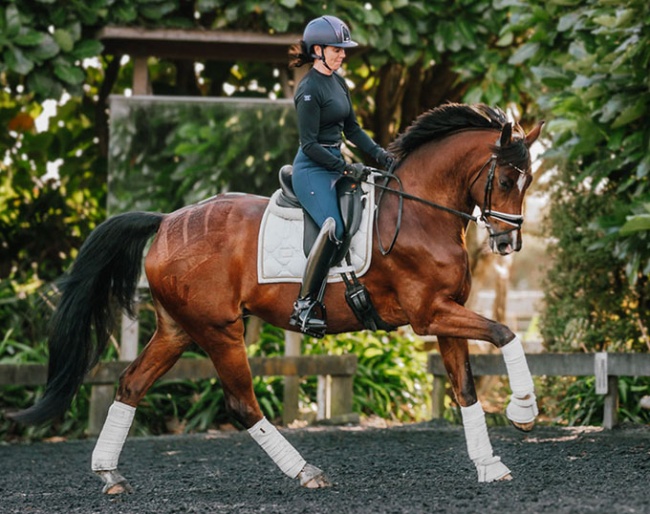
- Text by Sarah Warne-Furtado for Eurodressage
A topic of debate recently on dressage forums is the aid to canter, specifically if it is inside or outside leg that asks the horse to go to canter. I have witnessed it at dressage clinics, where the rider explains that they use the inside leg to ask for canter, and the instructor has to adjust the lesson accordingly.
Having always been taught to put my outside leg back slightly and shift my weight onto the inside seat bone, I was slightly puzzled as to why there is divergence in the teaching.
“To start canter I use outside leg, the inside leg keeps the horse going on and keeps the horse engaged,” says classical trainer Anna Beran. Author of several books on the art of classical riding, Anja insists that “all the people I know who work with horses like cowboys, or vaqueros for example, initiate the canter in this way”. To start with the inside leg seems to me like a modern idea.”
So is this a modern idea, to use inside leg as the aid for canter? And if it is a modern idea, why have we always been taught outside leg to ask for canter?
“Because a horse begins the canter with his outside hind leg, for example, the horse initiates the left canter with his right hind leg, and vice versa. So when we start with our outside leg, we "talk" directly to the outside hind leg of our horse,” explained Anja.
I wondered then why the confusion, and why some riders are being taught to use an inside leg aid to canter?
Anja feels that it’s possible some riders start with the inside leg, because they are afraid that the horse comes in with his croup when they use outside leg. “But if you know how to put a horse straight it is never a problem," she added.
The classical trainer goes on to advise riders that “when they start in the traditional way to canter (outside leg), it is much easier later on when you begin the flying changes”. “The horses understand at once what you are asking, and you can keep your legs more elegant and in a calm position.”
O-Judge and International rider and trainer Isobel Wessels agrees, and goes on to identify the other elements that are set in motion when you initiate the canter.
“I put my outside leg back, because the canter starts with the outside hind leg, but not very far back or too strong. By doing that is it then possible for me to keep my inside hip forward, so I can scoop the horse up with my inside leg. The first indication is the outside leg, but the inside leg is the leg that lifts the horse up and into the canter and guides him onto the outside rein,” said Isobel.
So the inside leg plays a vital role, it is just not the leg that sets it all in motion.
“As a rider you are always aiming to achieve the lightest possible aid, until one day you ask yourself “what do I do?” And the answer is hopefully “not very much,” says Isobel. “The aids become so subtle that just the hint of outside leg back, and thinking canter, sets all these tiny invisible aids in motion.”
According to the O-judge, the inside leg is used as part of the canter aid, but more to guide the horse.
“Sit up straight in the middle of the saddle, keep your hands in front of you, and slight push of the hip towards the elbows, and a slightly back outside leg to start the process, and a nudge from inside leg simultaneously.”
However, Isobel admits that if the rider is not conscious of what their legs are doing, and able to coordinate these movements simultaneously, it can lead to the rider just tightening with both legs and the horse stiffening into the transition.
“Yes, no lemon squeezes!” says Isobel. “If they can’t coordinate the hands and legs, so not to constrain the horse and cause tension, then I would not ask them to go to canter. I would go back, to balance their seat, and help them gain awareness and efficient use of their body on the horse.”
International Grand Prix rider from New Zealand Vanessa Way agrees, that until a rider can effectively use the outside leg to ask for canter, without tightening or losing balance, they cannot progress.
“The inside leg keeps the impulsion and is effective in activating the inside hind, but it’s the outside leg that must initiate the canter, as this is the aid for the flying changes,” said Vanessa. “If a rider is not using the outside leg to ask for canter, or is using too much inside leg, or tightening against the horse with both legs, you have to go back to develop subtle coordinated aids. This way you create a clear training path for the future.”